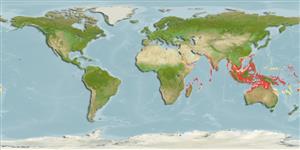Common names from other countries
Environment: milieu / climate zone / depth range / distribution range
Ecologia
marinhas associadas(os) a recifes; não migratória; intervalo de profundidade 1 - 60 m (Ref. 90102). Tropical; 25°N - 25°S
Indo-West Pacific: East coast of Africa, throughout Indonesia and New Guinea to New Caledonia, north to southern Japan.
Tamanho / Peso / Idade
Maturity: Lm ? range ? - ? cm
Max length : 45.0 cm TL macho/indeterminado; (Ref. 9710)
Espinhos dorsais (total) : 13; Raios dorsais (total) : 20 - 21; Espinhos anais: 3; Raios anais : 20.
Inhabits coastal reefs to at least 30 m (Ref. 9710). Adults often found in pairs inside caves (Ref. 9710, 48636). Juveniles settle in very shallow inshore habitats with short filamentous algae growth on rock or dead coral substrates (Ref. 48636). Feeds on sponges and tunicates (Ref. 48391). Undergoes a complete color transformation from the juvenile to adult stage. Regularly exported, e.g. from Sri Lanka, for the aquarium trade.
Ciclo de vida ou comportamento de acasalamento
Maturities | Reprodução | Spawnings | Egg(s) | Fecundities | Larvas
Steene, R.C., 1978. Butterfly and angelfishes of the world. A.H. & A.W. Reed Pty Ltd., Australia. vol. 1. 144 p. (Ref. 4859)
Status na Lista Vermelha da UICN (Ref. 130435)
CITES (Ref. 128078)
Not Evaluated
Ameaça para os humanos
Harmless
Uso pelos humanos
Pescarias: sem interesse; Aquário: Espécies comerciais
Ferramentas
Relatórios especiais
Baixar XML
Fontes da internet
Estimates based on models
Preferred temperature (Ref.
115969): 26.3 - 29.1, mean 28.3 (based on 1202 cells).
Índice de diversidade filogenética (Ref.
82804): PD
50 = 0.5001 [Uniqueness, from 0.5 = low to 2.0 = high].
Bayesian length-weight: a=0.03236 (0.01300 - 0.08052), b=2.89 (2.71 - 3.07), in cm Total Length, based on LWR estimates for this Genus-body shape (Ref.
93245).
Nível Trófico (Ref.
69278): 2.6 ±0.00 se; based on food items.
Resiliência (Ref.
120179): Baixo, tempo mínimo de duplicação da população 4,5 - 14 anos (Preliminary K or Fecundity.).
Fishing Vulnerability (Ref.
59153): Low to moderate vulnerability (35 of 100).
